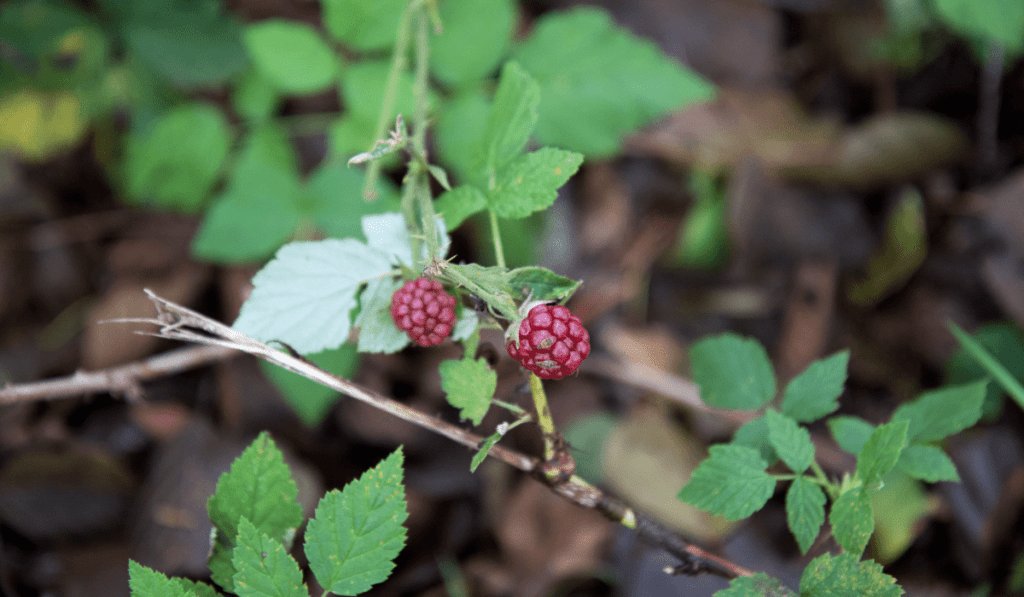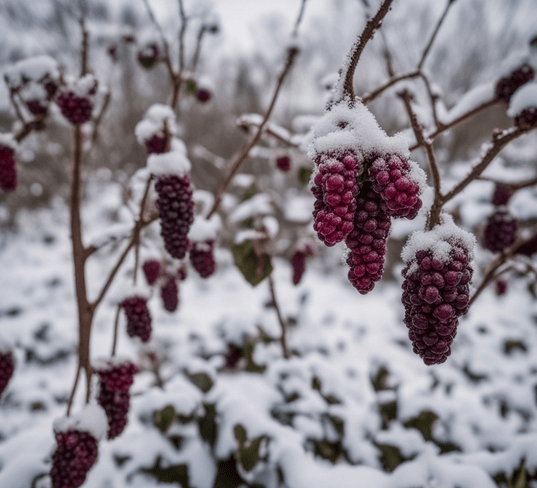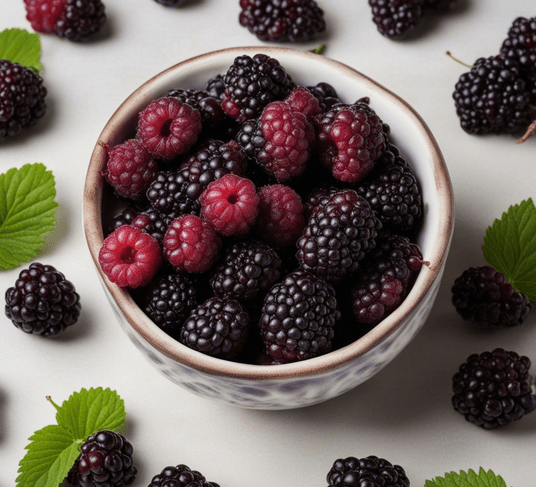Curious about threats to your boysenberry patch? Explore common pests like aphids and deer in this guide. Join us to fortify your berries. Gain knowledge to shield and ensure a thriving harvest. Ready to transform your garden? Let’s dive in!
Common Pests that Affect Boysenberries
Boysenberries, like any garden treasure, are not immune to the persistent threats posed by pests. Understanding the nature and characteristics of these intruders is the first step toward safeguarding your boysenberry patch.
Pest #1: Aphids
Aphids, the minuscule invaders, can wreak havoc on your boysenberry plants. Uncover the symptoms, effects, and the art of prevention and control in this comprehensive exploration.
Symptoms and Effects of Aphids on Boysenberries
Aphids extract sap, causing distorted growth, curled leaves, and a sticky residue known as honeydew. Their prolific nature can lead to widespread infestation, compromising the overall health of your boysenberry plants.
Prevention and Control Measures for Aphids
Our arsenal against aphids includes introducing natural predators like ladybugs, using neem oil, and maintaining impeccable garden hygiene. A proactive approach ensures these tiny marauders are kept in check.
Pest #2: Spider Mites
These minuscule arachnids may be small, but their impact on boysenberries can be significant. Explore the intricacies of identifying, preventing, and controlling spider mite infestations in your berry patch.
Symptoms and Effects of Spider Mites on Boysenberries
Spider mites, with their sap-sucking prowess, leave behind stippling, webbing, and leaf discoloration. The consequences can range from reduced chlorophyll production to premature leaf drop, affecting the overall health of your boysenberry plants.
Prevention and Control Measures for Spider Mites
Learn the delicate balance of encouraging natural predators, such as predatory mites, and employing targeted solutions like insecticidal soaps. By maintaining a healthy ecosystem, you fortify your boysenberries against these microscopic marauders.
Pest #3: Whiteflies
Delve into the ethereal world of whiteflies and their impact on boysenberries. Uncover the signs, effects, and effective strategies for preventing and controlling these airborne adversaries.
Symptoms and Effects of Whiteflies on Boysenberries
Whiteflies, with their tiny stature, can cause significant damage. Yellowing, wilting, and the spread of sooty mold are telltale signs of their presence, signaling potential trouble for your boysenberry plants.
Prevention and Control Measures for Whiteflies
Master the art of using insecticidal soap, introducing natural predators, and maintaining a vigilant eye on your boysenberry patch. A proactive stance against whiteflies ensures your berry haven remains pristine.
Pest #4: Fruit Flies
Explore the world of fruit flies and their potential impact on your boysenberry harvest. Uncover the signs, effects, and strategies for preventing and controlling these pesky invaders.
Symptoms and Effects of Fruit Flies on Boysenberries
Fruit flies, drawn to the sweetness of ripening berries, can cause significant economic losses. Larvae infestation within the fruit compromises its quality and marketability.
Prevention and Control Measures for Fruit Flies
From using traps to applying protective covers, discover the array of methods to keep fruit flies at bay. By implementing these strategies, your boysenberry harvest can be safeguarded against these tiny but troublesome foes.
Pest #5: Raspberry Cane Borers
Meet the covert invaders known as raspberry cane borers and their potential threat to boysenberries. Uncover their modus operandi, the impact on plants, and effective strategies for prevention and control.
Symptoms and Effects of Raspberry Cane Borers on Boysenberries
Raspberry cane borers target the very core of boysenberry plants, causing wilting, dieback, and a decline in overall health. Recognizing the early signs is crucial for timely intervention.
Prevention and Control Measures for Raspberry Cane Borers
Explore the use of pruning, proper sanitation, and targeted insecticides to thwart the efforts of these underground infiltrators. A vigilant approach ensures your boysenberry canes remain resilient and productive.
Pest #6: Thrips
Enter the microscopic world of thrips and their potential impact on boysenberry plants. Uncover the signs, effects, and proactive measures for preventing and controlling these tiny yet troublesome pests.
Symptoms and Effects of Thrips on Boysenberries
Thrips cause stippling, discoloration, and deformed growth in boysenberry plants. Their piercing-sucking feeding habits can compromise the appearance and health of developing berries.
Prevention and Control Measures for Thrips
Learn the delicate balance of introducing beneficial insects, maintaining garden hygiene, and using targeted solutions like insecticidal soaps. By doing so, you fortify your boysenberries against the ravages of thrips.
Pest #7: Slugs and Snails
Explore the ground-dwelling world of slugs and snails and their potential impact on boysenberry plants. Uncover the signs, effects, and effective strategies for preventing and controlling these slimy intruders.
Symptoms and Effects of Slugs and Snails on Boysenberries
Slugs and snails leave behind slime trails and chewed leaves, compromising the aesthetics and overall health of boysenberry plants. They are particularly active during damp conditions.
Prevention and Control Measures for Slugs and Snails
Discover the use of physical barriers, such as copper tape, and natural solutions like diatomaceous earth to deter these ground-dwelling pests. By employing these strategies, your boysenberry patch remains resilient against their slimy advances.
Pest #8: Birds
Enter the avian realm and explore the potential threat posed by birds to boysenberry harvests. Uncover the signs, effects, and strategic measures for preventing and managing these feathered adversaries.
Symptoms and Effects of Birds on Boysenberries
Birds, drawn to the ripe berries, can cause economic losses through pecking and feeding. The impact extends beyond aesthetics
Pest #9: Deer
Explore the impact of deer on boysenberry plants and strategies to prevent and control their presence in your berry haven.
Symptoms and Effects of Deer on Boysenberries
Deer, with their voracious appetites, can cause significant damage by browsing on leaves, stems, and even fruits. Their presence poses a threat to the overall health and productivity of your boysenberry plants.
Prevention and Control Measures for Deer
Discover the use of physical deterrents like fencing, scent deterrents, and strategic planting to discourage deer from entering your boysenberry patch. Implementing these measures helps safeguard your berries from the grazing habits of these herbivores.
Preventing and Managing Pests in Boysenberry Plants
Now that we’ve delved into the specifics of individual pests, let’s explore overarching strategies for preventing and managing pests in your boysenberry plants. From companion planting to proper sanitation practices, a holistic approach ensures a resilient and thriving berry patch.
Organic Pest Control Methods for Boysenberries
For those committed to organic gardening, explore a repertoire of effective and environmentally friendly pest control methods. From beneficial insects to organic sprays, discover ways to keep your boysenberries healthy without resorting to synthetic chemicals.
Conclusion
In the intricate dance between boysenberry cultivation and pests, knowledge and proactive measures are your greatest allies. By understanding the habits, symptoms, and control strategies for common pests, you empower yourself to protect your boysenberry bounty. Whether you’re facing tiny invaders like aphids or larger threats like deer, a vigilant and holistic approach ensures a fruitful harvest season after season. Happy cultivating!



